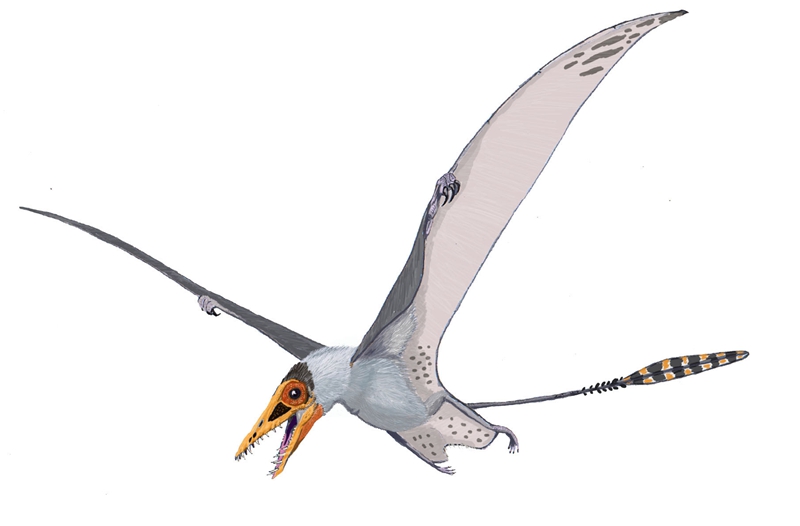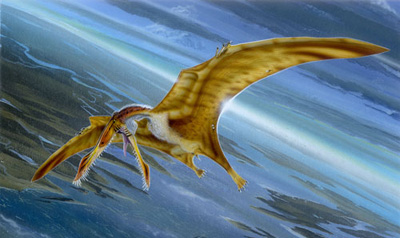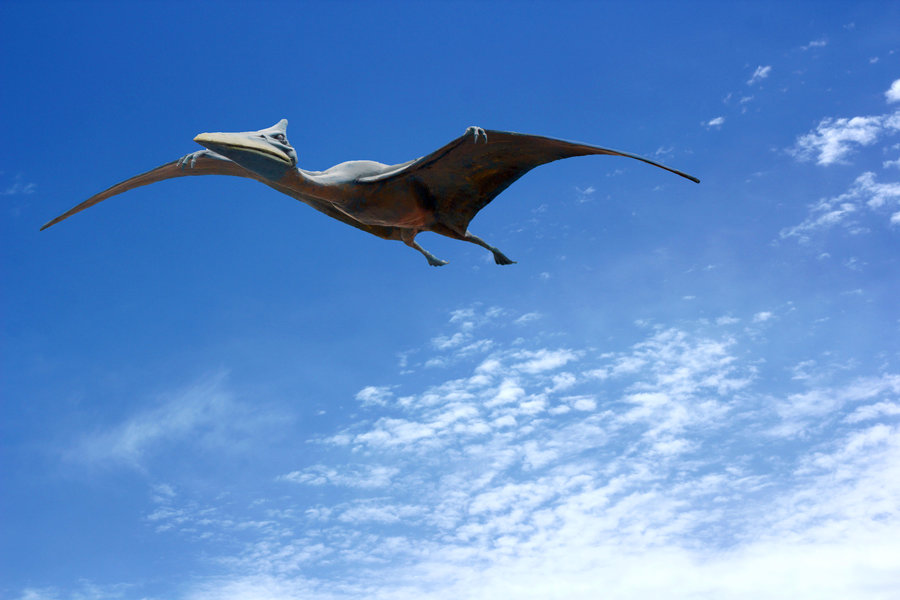Dinosaur Knowledge Tips Pterosaur
Release time:2017/10/23 13:51:00

Pterosaurs (;from the Greek "πτερόσαυρος", "pterosauros", meaning "winged lizard") were flying reptiles of the extinct clade or order Pterosauria. They existed from the late Triassic to the end of the Cretaceous (228 to 66 million years ago). Pterosaurs are the earliest vertebrates known to have evolved powered flight. Their wings were formed by a membrane of skin, muscle, and other tissues stretching from the ankles to a dramatically lengthened fourth finger.
Early species had long, fully toothed jaws and long tails, while
later forms had a highly reduced tail, and some lacked teeth. Many
sported furry coats made up of hair-like filaments known as pycnofibers, which covered their bodies and parts of their wings. Pterosaurs spanned a wide range of adult sizes, from the very small anurognathids to the largest known flying creatures of all time, including Quetzalcoatlus and Hatzegopteryx.
Pterosaurs are often referred to in the popular media and by the general public as "flying dinosaurs",
but this is scientifically incorrect. The term "dinosaur" is restricted
to just those reptiles descended from the last common ancestor of the
groups Saurischia and Ornithischia (clade Dinosauria, which includes birds), and current scientific consensus is that this group excludes the pterosaurs, as well as the various groups of extinct marine reptiles, such as ichthyosaurs, plesiosaurs, and mosasaurs.
Like the dinosaurs, and unlike these other reptiles, pterosaurs are more closely related to birds than to crocodiles or any other living reptile. Pterosaurs are also colloquially referred to as pterodactyls, particularly in fiction and by journalists.Technically, "Pterodactyl" refers only to members of the genus Pterodactylus, and more broadly to members of the suborder Pterodactyloidea of the pterosaurs.

The anatomy of pterosaurs was highly modified from their reptilian ancestors by the adaption to flight. Pterosaur bones were hollow and air-filled, like the bones of birds. They had a keeled breastbone that was developed for the attachment of flight muscles and an enlarged brain that shows specialised features associated with flight. In some later pterosaurs, the backbone over the shoulders fused into a structure known as a notarium, which served to stiffen the torso during flight, and provide a stable support for the scapula (shoulder blade).
Pterosaur wings were formed by membranes of skin and other tissues. The primary membranes attached to the extremely long fourth finger of each arm and extended along the sides of the body to the ankles.
While historically thought of as simple leathery structures composed
of skin, research has since shown that the wing membranes of pterosaurs
were highly complex dynamic structures suited to an active style of
flight. The outer wings (from the tip to the elbow) were strengthened by
closely spaced fibers called actinofibrils. The actinofibrils themselves consisted of three distinct layers in the
wing, forming a crisscross pattern when superimposed on one another. The
function of the actinofibrils is unknown, as is the exact material from
which they were made. Depending on their exact composition (keratin,
muscle, elastic structures, etc.), they may have been stiffening or
strengthening agents in the outer part of the wing. The wing membranes also contained a thin layer of muscle, fibrous
tissue, and a unique, complex circulatory system of looping blood
vessels.
As shown by cavities in the wing bones of larger species and soft
tissue preserved in at least one specimen, some pterosaurs extended
their system of respiratory air sacs (see Paleobiology section below)
into the wing membrane.

The first pterosaur fossil was described by the Italian naturalist Cosimo Alessandro Collini in 1784. Collini misinterpreted his specimen as a seagoing creature that used its long front limbs as paddles. A few scientists continued to support the aquatic interpretation even until 1830, when the German zoologist Johann Georg Wagler suggested that Pterodactylus used its wings as flippers. Georges Cuvier first suggested that pterosaurs were flying creatures in 1801, and coined the name "Ptero-dactyle" in 1809 for the specimen recovered in Germany. However, due to the standardization of scientific names, the official name for this genus became Pterodactylus, though the name "pterodactyl" continued to be popularly and incorrectly applied to all members of Pterosauria. Paleontologists now avoid using "pterodactyl" and prefer the term
"pterosaur". They relegate the term "pterodactyl" specifically for
members of the genus Pterodactylus or more broadly for members of the suborder Pterodactyloidea.
from Wikipedia